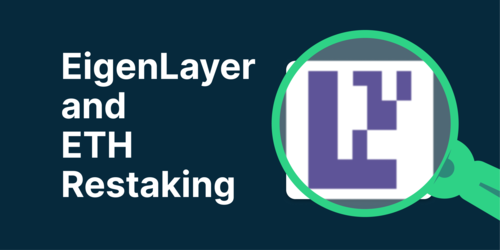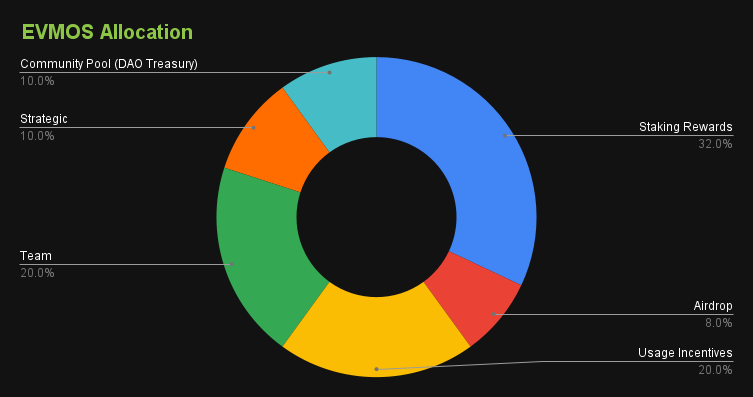
What is EigenLayer?
EigenLayer is a middleware that is built on the Ethereum network, which lets protocols that integrate with it leverage Ethereum’s highly secure trust network without needing to establish its own validator set.
Key Takeaways
-
EigenLayer is a middleware build on the Ethereum network to commoditize decentralized trust
-
Protocols have lower cost barriers to kick-start when they are able to leverage on Ethereum’s highly robust security layer
-
Users benefit from increased capital efficiency by having the option to restake their ETH, in turn receiving more staking rewards
EigenLayer recently caught the market’s attention with their Series A $50 million raise, led by Blockchain Capital and attracting prominent investors including Polychain Capital, Electric Capital, Coinbase Ventures and Ethereal Ventures.
EigenLayer is a middleware that is being built on the Ethereum network to commoditize decentralized trust. Protocols that look to integrate EigenLayer will be able to leverage Ethereum’s highly secure trust network. This allows protocols to kick-start their launch with much less cost, since they do not have to bootstrap an entire validator set through reward incentives. This significantly increases the potential innovations that could be developed by protocols, as it frees up startup capital.
In this article, we will be exploring what EigenLayer is, its benefits, and its use cases.
What is EigenLayer
As mentioned earlier on, EigenLayer is building out to become a marketplace for decentralized trust. This means that protocols can integrate EigenLayer to leverage Ethereum’s underlying security by ‘renting’ it. This is achieved by allowing ETH stakers to restake their ETH to secure these protocols.
The goal of EigenLayer is to create a much more robust blockchain ecosystem, with the bulk of protocols being highly secure.
What Is Restaking?
Let’s delve a little deeper into what restaking is about. To put it simply, restaking allows users to stake the same ETH on both Ethereum and on other protocols, securing all of these networks simultaneously. Hence, restaking allows for leverage of existing trust networks.
However, when users opt-in to restake their ETH, they are being exposed to increased slashing risk. As a result, restakers are compensated with higher staking rewards for undertaking more risk.
How to Restake
There are multiple restaking methods offered by EigenLayer (risk level from least to most):
-
Native Restaking: Validators restake their staked ETH
-
LSD Restaking: Validators restake assets that are already staked via liquid staking providers, including Lido, Rocket Pool etc.
-
LSD LP Restaking: Validators restake the LP token of a pair which includes a liquid staking ETH token
-
ETH LP Restaking: Validators restake the LP token of a pair which includes ETH.
The above can be visualized with this diagram:

Source: Messari
The ultimate restaking method chosen by users will be dependent on the level of risk they are willing to take on and the kind of positions they already hold.
Problems Tackled by EigenLayer
EigenLayer’s architecture tackles multiple problems that are being faced by the market today.
1. Difficulty and Cost Inefficiency in Establishing Protocol Security
The validator set belonging to a protocol holds the key to the level of protocol security. Currently, protocols that are built on top of the Ethereum network are required to bootstrap their own set of validators, which needs to be sufficiently large in size to achieve decentralization. This becomes a bottleneck to developers due to two reasons. The first being that they will have to fork out a large amount of capital to incentivize the validators to secure the network. The second being that the time taken to manage the validators takes away the time developers have to further the protocol development.
One evident example of this would be the sky high annual percentage rate (APR) that some protocols have to provide to attract stakers to secure their network. This APR that is given to users comes in the form of token emissions, which draws down on the network’s treasury. An example can be seen from the diagram below, which depicts the tokenomics of the Evmos protocol. It can be observed that a very large portion of the tokens (40% < 4 years, now 32%) have to be allocated to ‘Staking Rewards’ to attract and maintain a sufficiently large set of validators.

Source: Evmos Tokenomics
2. Lack of Sovereignty
Protocols that wish to build on Ethereum are required to adhere to the fundamental set of rules that have been incorporated into Ethereum. Hence, these protocols will face a limit to the extent of innovation they can achieve. This lack of sovereignty has been a factor which drives developers to build on other chains such as Cosmos which grants them a higher level of customizability.
3. Lack of Trust in Other Protocols
A protocol is often dependent on various other protocols for certain functions, with an example being oracles. However, given that these protocols might be built on chains other than Ethereum, it translates to a lower level of security. Hence, this poses a security risk to users because the protocol’s security is only as good as the security of the weakest component, as depicted by the figure below.

Source: Kirill Naumov’s Twitter
Benefits of EigenLayer
Now that we have understood the problems that EigenLayer is trying to tackle, we can have a deeper look into the benefits EigenLayer brings about.
1. Increased Protocol Security
With EigenLayer, protocols will be able to tap on Ethereum’s security layer by incentivizing ETH stakers to stake on their protocol. This helps the protocol to gain access to a much larger set of validators, and improve their initial security.
2. High Degree of Flexibility
By building on EigenLayer, protocols will be able to retain sovereignty and have the freedom to customize their architecture, including the type of consensus mechanism, slashing conditions etc.
3. Increased Capital Efficiency
Given the ability to restake ETH, stakers can now earn rewards from multiple protocols with the same capital.
Capital efficiency has proven to be favored by the market, with liquid staking derivatives including Lido and Rocketpool receiving widespread market interest. Governance tokens of such protocols, LDO and RPL, have also experienced huge increase in prices. With EigenLayer, this capital efficiency benefit is increased further, since users are able to stake their ETH across more than one other protocol.
EigenLayer’s Use Cases
One of the most prominent use cases of EigenLayer right now is EigenDA, which is a decentralized data availability layer secured by Ethereum. With EigenDA, the gas fees on Layer 2s (L2s) can be reduced significantly. This is made possible because EigenDA is a separate data availability protocol, secured by Ethereum’s security. This is in contrast to existing infrastructure where data availability is in-built into Layer 1s. The biggest bottleneck that arises from this would be network congestion, since the Layer 1 network has to carry out all the different aspects including execution, data storage and more, which inevitably leads to higher gas fees. In addition, EigenDA also provides higher bandwidth for data availability. The existing Ethereum base layer is able to process 80 kilobytes (KB) per second, while EigenDA is looking to offer up to 10 megabytes (MB), which is order of magnitudes higher.
One of the existing partners is Mantle, a modular Ethereum L2. Mantle utilizes EigenDA as its data availability layer. By separating the data availability layer while leveraging on Ethereum’s security through the restaked ETH, Mantle is able to reduce L2 transaction fees by approximately 80% as compared to existing L2s. This could potentially attract a large number of users.
EigenLayer has also presented the possibility of improving the censorship problem faced in the maximal extractable value (MEV) vertical. The transition of Ethereum from Proof-of-Work consensus mechanism to a Proof-of-Stake consensus mechanism had introduced the issue of censorship. Since EigenLayer introduces slashing for misbehaving blocks proposers, any malicious activity would face slashing, tackling the censorship problem. To have a better understanding of this, you can refer to this article here.
Conclusion
EigenLayer is one of the most interesting protocols that have been built in recent periods. With its architecture, it is able to benefit multiple parties, including developers working on protocols who now have access to limitless innovation possibilities and market participants who are able to make use of their capital to earn more rewards. More importantly, we can foresee the blockchain landscape becoming increasingly robust given the improved security and innovation that can be brought to the market. This will be a critical driving force in attracting more users to come and participate in the ecosystem.
With the testnet live, we’ve put together a guide on interacting with the EigenLayer testnet to better understand how it works (and potentially scoring some tokens if an EigenLayer airdrop happens).
Tell us how much you like this article!
CJ
CJ is a business graduate that has been involved in crypto for 4 years and specializes in DeFi protocols. He is also interested in TradFi becoming DeFi, and has written for ByBit, SwitcheoLabs, and others.
Follow the author on Twitter @fishmarketacad
